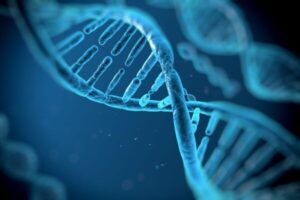Genetics

Noonan syndrome is caused by a fault in one of several genes. The commonest gene involved is called PTPN11 but there have now been around 15 genes discovered which may cause Noonan syndrome or a related disorder. Genetic testing can be used to confirm the diagnosis of Noonan syndrome and also to test for the condition in pregnancy.
History
The first clinical description of what we now term Noonan Syndrome is thought to have been published by Estonian student Oskar Kobyliński in 1883. While a student at the University in Dorpat (now Tartu, Estonia), he reported on a patient with a webbed neck, which he termed ‘flüghautige Verbreitung des Halses’ (wing-like extension of the neck). This was followed by descriptions of similar cases in 1902 and 1930.
In 1962, at the Midwest Paediatric Research Meeting, Dr Jacqueline Noonan presented a clinical study of nine children who had congenital heart disease as well as other anomalies. The nine patients – six males and three females – shared distinctive facial features and had a short stature, pulmonary stenosis (problems with a major heart valve) and significant chest deformities. She published her research on these nine and an additional ten patients in the American Journal of Diseases of Children in 1968.
As Dr Noonan was the first to indicate that this condition occurs in both sexes, can be inherited in certain cases, includes congenital heart defects and is associated with a normal number of chromosomes, the eponym Noonan syndrome was proposed.
Thickening of the heart muscle (hypertrophic cardiomyopathy), which occurs in some patients with Noonan syndrome, was first described in 1972.
Research on the genetics of Noonan syndrome often looked at the X chromosome, as people with Turner syndrome – which results from a single X chromosome only, rather than the usual XX or XY chromosomes – and Noonan syndrome have some similar physical characteristics. (Indeed, in 1938 the term ‘male Turner syndrome’ had been proposed, causing some confusion.). But in 1994, a link between Noonan syndrome and chromosome 12 was found.
In 2001, this link was narrowed down to a genetic change – a mutation – in the PTPN11 gene on chromosome 12, present in about half of patients with Noonan syndrome. Since then, other genes have been found to be associated with Noonan syndrome.
Inheritance
In the majority of people with the condition – about 60% – Noonan syndrome is caused by a new genetic change in the egg or sperm and so there is no family history. In this case, the chance of the parents having another child with Noonan syndrome is very small. This is termed ‘sporadic’ as it is caused by a ‘new mutation’.
In some people, however, the faulty gene associated with Noonan syndrome is inherited from one parent – who may or may not have obvious features of the condition themselves. Only one parent needs to carry the fault to pass it on, and each child they have has a 50% chance of being born with the condition. This type of inheritance is called ‘autosomal dominant’.
There is a very rare ‘autosomal recessive’ form of Noonan syndrome. This involves two parents who do not have the condition each having a particular faulty gene (LZTR1). In this case, Noonan syndrome may occur if a child inherits two copies of the faulty gene – one from each parent.
The genes
The most common genetic cause of Noonan syndrome is a mutation in a gene called PTPN11. This was discovered in 2001 and, since then, other genes have been linked to the condition.
- A mutation in PTPN11 occurs in about 50% of people with Noonan syndrome.
- SOS1 is the second most common causative gene, with variants occurring in 16–20% of individuals without PTPN11 variants.
- Mutations in other genes – RAF1, RIT1, KRAS, NRAS, BRAF, MAP2K1, RRAS, RASA2, SOS2, LZTR1 – are less common causes.
- In about 5–10% of cases, the genetic cause of Noonan syndrome is still not known.
The genes associated with Noonan syndrome play a crucial role in the Ras-mitogen-activated protein kinase (Ras/MAPK) pathway, which is involved in the development and growth of cells in the body. Several other syndromes are also associated with the Ras/MAPK pathway; collectively, the group of syndromes are known as the RASopathies [link to page on RASopathies] and they share many similar features.

